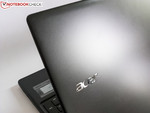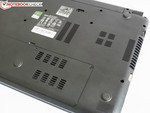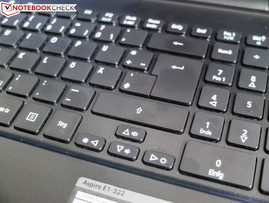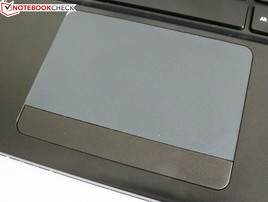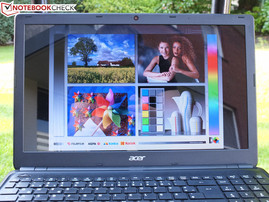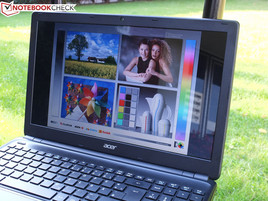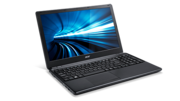Review Acer Aspire E1-522-45004G50Mnkk Notebook

For the original German review, see here.
Potential buyers are faced with a dizzying array of devices from the many different manufacturers in the budget office laptop sector. One of the top-selling manufacturers in the lowest price range who dominated this category with netbooks (featuring a slow yet energy-efficient Atom single-core platform) a few years ago, is traditionally Acer. Besides the Aspire E1-522-45004G50Mnkk with AMD's A4-5000 CPU (4x 1.5 GHz; TDP 15 W), AMD's Radeon HD 8330 on-chip GPU, 4 GB of RAM and a 500 GB HDD tested here, it lists over 60 different versions of the E1 on its website. However, only a few feature the same, completely black casing of our review sample.
Another interesting E1 model is, for example, Acer's Aspire E1-572G-54204G75Mnkk that differs from the otherwise identical review sample with a faster dual-core Intel Core i5 4200U (2x 1.8 GHz; TDP: 17 W), dedicated AMD Radeon HD 8750M with its own 2 GB of memory and a 750 GB hard drive. Although it is almost 50% more expensive, it is still below 600 Euros (~$798). Samsung's ATIV Book 2 - 270E5E that we tested late July 2013 is within the same price range as the review sample, and which we will use for comparison due to its good ratings, is based on a dual-core Intel Pentium 2117U from Intel's Ivy Bridge architecture and features a TDP of 17 Watts but lacks Hyperthreading. Lenovo's G500s-59367693 is our third comparison device. It is also available for below 400 Euros (~$532) and is powered by an Intel Pentium 2020M with integrated Intel HD graphics and, unlike the other laptops, has a higher TDP of 35 Watts but is otherwise identically equipped.
How Acer's Aspire E1-522-45004G50Mnkk will fare in everyday use and in our benchmarks compared with the contenders and whether the present combination of office-suitable equipment, that also points toward multimedia with features like the DVD drive and glossy screen surface, makes sense will be clarified in the following test report.
Case
The casing looks exactly like what can be expected from this price range. Buyers who expect high-quality looking materials, such as metal and glass, will have to dig much deeper in their pockets. Only ordinary black plastic is offered for 400 Euros (~$532). The display, keyboard and wrist rest bezel area are smooth while the casing's lower part and hinge feature a texture that is to supply more grip for transportation. The sleek surfaces are generally sensitive and susceptible to fingerprints that can also only be removed with a bit of effort.
Considering the choice of materials, it is not surprising that the base warps without much force. The lid is, unfortunately, quite unstable. Consequently, light pressure on the back becomes visible on the screen. The lid can easily be opened with one hand without any fiddling and the base stays down. The maximum possible angle of approximately 160° is agreeable. The hinge keeps the lid firmly in position but does not prevent the display from wobbling on the go in the car or on the train. However, such excursions will likely be rare considering the size and weight of Acer's E1-522.
All in all, the casing is plain and dull but it makes a solid impression and is thus sufficient for its typical field of use as a stationary work laptop. We did not ascertain any irregularities such as protruding edges or uneven gaps.
Connectivity
Acer's Aspire E1-522-45004G50Mnkk features standard-sized ports so that an adapter is unnecessary. The positioning of the interfaces on the laptop's sides is well done. The three USB ports (2x USB 2.0 right, 1x USB 3.0 left) are in the front area. The HDMI, VGA and Ethernet are located on the left while the DVD drive is in the right back. The status LEDs and an SD card slot are on the left front. The ports on the left might interfere with mouse use on this side. There are no special features such as a DisplayPort, eSATA or ExpressCard slot. However, this should still be tolerable for the target group and keeps the price low.
Communication
Bluetooth in the latest 4.0 version and Qualcomm Atheros' AR956x Wi-Fi chip besides Gigabit LAN (Qualcomm Atheros AR8171/8175) are installed for communication purposes. We did not notice any irregularities while using the wireless modules. The dual-band Wi-Fi standard 802.11 a/b/g/n displayed three to four bars in the office, even when separated by three drywall constructions and a distance of approximately 10 meters (~33 feet). Subjectively, it enabled uninterrupted browsing.
Accessories and Software
As is common for budget laptops, there is not much on the list here. The accessories are limited to the most necessary things. Besides the compulsory power supply and the cords, we only find a quick start guide and notes. Recovery media is not included.
As to software, at least McAfee Internet Security Suite is preinstalled. Other programs, such as the cloud-based Acer products clear.fi Photo and clear.fi Media are not really worth mentioning and will likely soon be replaced by stronger alternatives. One or another user may find the Acer Power Button useful as it enables switching the E1-522's operating state (lock, energy saving, standby, reboot, shut down) without the fuss common for Windows 8.
Maintenance
The maintenance cover is secured with three Philips screws and enables access to the hard drive as well as both RAM banks. Only one of the latter is furnished with a 4 GB bar in single-channel mode. The fan cannot be accessed via the cover.
Warranty
Acer's standard 24-month carry-in warranty is included, as for all its laptops. The warranty can be upgraded to 3 years for approximately 70 Euros (~$93) and to four years for 110 (~$146). The upgrades include a one-year international coverage.
Input Devices
Keyboard
Acer exploits the entire available space and equips its E1-522 with a keyboard featuring a layout very similar to a standard desktop keyboard. It also has a dedicated number pad whose keys are just as big as the letter keys. The somewhat small cursor keys are below the right shift key and the CRTL keys are the same size as the letter keys. The usual, blue-lettered FN key that might control multimedia functions or the screen's brightness is located in the lower left between the CRTL and Windows key.
The drop of the completely level and slightly roughened keys is generous for today's standards. The pressure point is clear, alongside the largely standard desktop layout, it enables quick familiarization and consequently normal typing speed will soon be achieved. Users who like it quiet when typing will be satisfied with Acer's laptop because it is inconspicuous in this point.
Touchpad
The ELAN PS/2 Port Smart-Pad multi-touch pad is a pleasant size. It is off-center to the left; nevertheless, there is enough room on the left wrist rest. The mouse keys below it are not visibly separated and work as usual. They stand out with a short drop and a clearly palpable pressure point, which also provides an audible click feedback. The lightly matted surface is not completely sensitive up to the edges. There are no scroll bars and they cannot be enabled in the driver. The touchpad detects up to three touch points at the same time and supports a few gestures, such as drag and drop, scroll and edge swipe, which can be configured more precisely. Pinch-to-zoom and scrolling with two fingers, for example on websites, is also possible. Multi-finger gestures are detected quickly and accurately. In terms of ergonomics and functionality, there is no reason for complaint in the tester's opinion.
Display
The glossy screen is based on TN technology with an LED backlight. It features a 16:9 format and has a WSXGA resolution of 1366x768 pixels, which is also known as HD-ready. Alongside a diagonal of 15.6 inches, this adds up to a rather modest pixel density of around 100 ppi. 15.6-inch screens with a Full HD resolution of 1920x1080 pixels achieve 141 ppi. For clarification: People with 20/20 eyesight still have a visual discrimination of approximately 188 ppi from a normal distance of 45 cm (~18 inches) to the screen. Consequently, single pixels can be seen with the naked eye; diagonal lines display steps and letters are not always perfectly focused. Icons and controls are fairly large in relation to the overall surface, which reduces the productive, usable space. The screen's pixel grid is also visible when looking closer, but this is not noticed in routine use.
To save Acer's honor on this point, we have to note that this resolution is standard for the targeted price range and users would have to exhaustively search for a device with the next higher resolution of 1600x900 pixels (118 ppi).
In terms of brightness, we expect at least 200 cd/m² in a laptop from this price range. Rates beyond 250 cd/m² are scarce here. Our review sample marginally fails this mark with a maximum brightness of only 187 cd/m², which is also fortunately maintained in battery mode. Acer's virtually identically equipped Aspire E1-572G-54204G75Mnkk also only comes close to our expectations with 195 cd/m². Samsung's ATIV Book 2 - 270E5E proves that this can be better in this price range with 231 cd/m² while Lenovo's G500s-59367693 does not excel in this exercise with 213 cd/m². The tester always felt the urge to turn up the brightness as far as possible to achieve a sufficiently bright picture, even in artificially illuminated rooms. All devices feature an average brightness over the entire screen that is slightly below the maximum brightness in a proportionate ratio.
The illumination of 82% from Acer's E1-522 is within the average of the comparison laptops. In view of the low maximum brightness, the ascertained minimum of only 153 cd/m² (right middle) causes shadowing that is visible to the naked eye. However, this is only noticed in very dark contents.
| |||||||||||||||||||||||||
Brightness Distribution: 82 %
Center on Battery: 187 cd/m²
Contrast: 779:1 (Black: 0.24 cd/m²)
ΔE Color 12.43 | 0.5-29.43 Ø5
ΔE Greyscale 13.15 | 0.57-98 Ø5.3
35.05% AdobeRGB 1998 (Argyll 1.6.3 3D)
37.65% AdobeRGB 1998 (Argyll 2.2.0 3D)
53.3% sRGB (Argyll 2.2.0 3D)
36.57% Display P3 (Argyll 2.2.0 3D)
Gamma: 2.46
Budget laptops are usually not known for their color accuracy either and the review sample is no exception. Colors are partly rendered with major deviations over the entire saturation and brightness scale, which are very visible as a bluish cast. The screen is far from reproducing the AdobeRGB or the much smaller sRGB color space, which is only significant to professional users.
On the other hand, we like the unusually high contrast of 767:1, which is rare in this category. It easily defeats the contenders: Samsung ATIV Book 2: 470:1 and Lenovo G500s: 313:1. The good black value of 0.24 cd/m² is also appealing and competes against rates ranging from 0.50 cd/m² and 0.60 cd/m². Nevertheless, these results do not improve the screen's weak overall impression.
The low maximum brightness of below 200 cd/m² alongside the glossy screen extremely restricts outdoor use. Although it is still possible to work fairly well with the device in the shade on a sunny day, as soon as the sun shines on the screen from the side or from the back it becomes impossible because reflections overlay everything.
TN screens such as the one installed here suffer under poor viewing angle stability among other things. While they are still tolerable when changing the horizontal position, slight deviations in the vertical viewing angle are enough to cause massive losses in the image quality.
Performance
Acer's Aspire E1-522-45004G50Mnkk has to be classified as a budget office laptop that strays a bit in the multimedia field with its DVD drive. It is powered by AMD's A4-5000 quad-core APU, which has sufficient 4 GB of RAM available. AMD's Radeon HD 8330 without a dedicated graphics memory is integrated in the APU and clocks with 500 MHz. A conventional 500 GB hard drive from Toshiba, which spins with 5400 rpm, is installed as the storage device.
The resulting power is easily enough for the typical use as an office computer. Office programs load fairly fast and Internet browsing is smooth. Even rendering HD media is no problem. However, as soon as somewhat hardware-hungrier programs are used, such as Adobe Photoshop Lightroom 4 image editing software, the tested configuration of Acer's E1-522 soon finds its limits. The largely identical Acer Aspire E1-572G-54204G75Mnkk all-round laptop for approximately 600 Euros (~$798) is more suitable because it provides more performance reserves with the much faster dual-core Intel Core i5-4200U (2x 1.8 GHz; TDP: 17 W) and the dedicated AMD Radeon HD 8750M. As mentioned above, Acer offers the E1 laptops in various configurations that cover a wide spectrum of applications.
Processor
AMD's A4-5000 is a quad-core with 4x 1.5 GHz from the Kabini production line. Like the processors in the new Xbox One and Playstation 4, it is based on the Jaguar architecture and is built in a 28 nm process. However, its performance is not comparable with the models in the consoles. The low TDP of 15 Watts designates the APU for use in affordable, entry-level laptops and subnotebooks made for mobility.
Acer's E1-522 achieves a class-average score of 5071 points in Cinebench R10 multi-rendering (64-bit). The difference to other laptops based on the same hardware is less than 2%. The assessment using Cinebench R11.5 OpenGL 64-bit confirms this result. The laptop's full power is also available in battery mode. Our reference Samsung ATIV Book 2, featuring Intel's Pentium 2117U and the identically equipped Lenovo IdeaPad S300-MA14CGE are approximately 15% faster in Cinebench R10 multi-rendering (64-bit). PCMark's Productivity Score even records a roughly 38% higher performance for the Intel platform. Almost twice the performance is possible for 200 Euros (~$266) more in Acer's Aspire E1-572G-54204G75Mnkk from the E1 series owing to Intel's Core i5-4200U and AMD's Radeon HD 8750M dedicated graphics.
System Performance
We use PCMark 7 and PCMark Vantage to assess the system performance. The review sample is exactly on a par with most other laptops that are based on the same platform in the first benchmark. Only Toshiba's Satellite C75D-A7286 breaks away by 15% in this group. PCMark Vantage supplies a different picture. Acer's E1-522 takes a lead of 14% on its contenders Toshiba's Satellite C50D-A-10E and Packard Bell's EasyNote LE69KB-45004G50Mnsk.
Our Lenovo G500s-59367693 comparison laptop with Intel's Pentium 2020M (2x 2.4 GHz; HD Graphics) achieves a 37% higher Productivity Score while a 66% productivity advantage is recorded in PCMark 7. The Pentium 2117U in the ATIV Book 2 has a 38% lead on the Acer here.
The four cores in AMD's A4-5000 do not provide an advantage compared with the two cores in the Pentium CPUs that do not even feature Hyperthreading. This is because the computing power of the single cores in the Intel CPUs is much higher, which is also due to the higher clock rate (2117U: 1.8 GHz; E2020M: 2.4 GHz). The nominal TDP of the E2020M is also 35 Watts in contrast to the 15 Watts of the A4-5000 and 17 Watts of the 2117U.
The system sometimes proved to be a bit sluggish but sufficiently smooth in routine use. The system boots quickly and relevant programs will launch just as fast.
| PCMark 7 - Score (sort by value) | |
| Acer Aspire E1-522-45004G50Mnkk | |
| Lenovo G500s-59367693 | |
| Samsung ATIV Book 2 - 270E5E | |
| Acer Aspire E1-572G-54204G75Mnkk | |
| PCMark Vantage - 1024x768 Result (sort by value) | |
| Acer Aspire E1-522-45004G50Mnkk | |
| Lenovo G500s-59367693 | |
| Samsung ATIV Book 2 - 270E5E | |
| Acer Aspire E1-572G-54204G75Mnkk | |
| PCMark Vantage Result | 3436 points | |
| PCMark 7 Score | 1469 points | |
Help | ||
Storage Devices
The installed 500 GB hard drive is Toshiba's MQ01ABD050 model that spins at 5400 rpm. There generally are a few advantages and disadvantages compared with 7200 rpm drives. Faster drives primarily benefit from shorter access times and speedier data transfers. However, they do not even come close to the vastly superior SSDs in these fields. In return, slower drives are not as noisy, cooler, less vibrating and consume less power. They also usually have a longer lifespan.
Modern, 5400-rpm laptop hard drives are generally not far apart in performance. Toshiba's drive is no exception. The hard drive benchmark HD Tune measures and averages access times (17.7 ms) and transfer rates (81.1 MB/s), which range within a narrow corridor with comparable HDDs and are just as good as many 7200 rpm models. The hard drive in Lenovo's G500s, for example, achieves 86.5 MB/s (+/5) and the one in the ATIV Book 2 reaches 79 MB/s (-3). Both 5400-rpm drives in the comparison models have slightly faster access times. The Lenovo has an insignificant advantage of 6% in practical use and Samsung has a 24% lead on the Acer.
An overview of the benchmark results for many hard drives and SSDs can be found in our FAQ section.
Graphics Card
AMD's on-chip Radeon HD 8330 GPU deals with graphic calculations, but does not feature a dedicated memory. The clock rate of the 128 Shader units is fixed at 500 MHz. In terms of performance, the GPU is roughly on a par with Intel's HD 4000 that is integrated in most CPUs from Intel's Ivy Bridge generation. Although the Radeon HD 8330 supports DirectX 11.1, it is only suitable for older and/or graphically undemanding games.
Depending on the benchmark, Acer's Aspire E1-572G-54204G75Mnkk multimedia laptop achieves between 220% (3DMark 2013 Ice Storm Graphics) and 320% (3DMark 2013 Cloud Gate Graphics) of the review sample's pure graphics performance, owing to the dedicated graphics unit and faster processor. Samsung's ATIV Book 2 achieves a lead of 15 to 30% on Acer's E1-522.
| 3DMark 03 Standard | 9634 points | |
| 3DMark 05 Standard | 5020 points | |
| 3DMark Ice Storm Standard Score | 25635 points | |
| 3DMark Cloud Gate Standard Score | 2236 points | |
Help | ||
Gaming Performance
The gaming power of the E1-522 is innately not high. Besides the aforementioned benchmarks, we also tested the performance using the games Anno 2070, Bioshock Infinite and Tomb Raider. The building strategy game Anno 2070 did not even start in "High" settings and could only be played in low settings. Here it only achieved a just still playable 34.2 fps. The fun was also ruined in medium settings with only 15.3 fps. It looks pretty much the same in the shooter Bioshock, where the office laptop only managed 22.8 fps in "Low" settings. It nosedived to 8.9 fps in "High". Tomb Raider was barely playable with an average of 25.2 fps in "Low" settings. It was unplayable with 12.9 fps in medium settings.
Acer's E1-522 does as good or as bad a job as can be expected from AMD's A4-5000 platform. The differences to alternatives that also sport this APU are always below 10%. The ATIV Book 2 lags behind the Acer by roughly 10 to 30% depending on the game and the settings. Lenovo's G500s-59367693 with a Pentium 2020M and 35 Watt TDP places itself somewhere between that with a deficit of around 10 to 20%.
A benchmark list of many mobile graphics cards as well as details about the used games can be found in our FAQ section.
| Anno 2070 | |
| 1024x768 Low Preset (sort by value) | |
| Acer Aspire E1-522-45004G50Mnkk | |
| Lenovo G500s-59367693 | |
| Samsung ATIV Book 2 - 270E5E | |
| 1366x768 Medium Preset AA:on (sort by value) | |
| Acer Aspire E1-522-45004G50Mnkk | |
| Lenovo G500s-59367693 | |
| Samsung ATIV Book 2 - 270E5E | |
| BioShock Infinite | |
| 1280x720 Very Low Preset (sort by value) | |
| Acer Aspire E1-522-45004G50Mnkk | |
| Samsung ATIV Book 2 - 270E5E | |
| 1366x768 Medium Preset (sort by value) | |
| Acer Aspire E1-522-45004G50Mnkk | |
| Samsung ATIV Book 2 - 270E5E | |
| Tomb Raider | |
| 1024x768 Low Preset (sort by value) | |
| Acer Aspire E1-522-45004G50Mnkk | |
| Lenovo G500s-59367693 | |
| Samsung ATIV Book 2 - 270E5E | |
| Acer Aspire E1-572G-54204G75Mnkk | |
| 1366x768 Normal Preset AA:FX AF:4x (sort by value) | |
| Acer Aspire E1-522-45004G50Mnkk | |
| Lenovo G500s-59367693 | |
| Samsung ATIV Book 2 - 270E5E | |
| Acer Aspire E1-572G-54204G75Mnkk | |
| low | med. | high | ultra | |
| Anno 2070 (2011) | 34.19 | 15.34 | ||
| Tomb Raider (2013) | 25.2 | 12.9 | 8.9 | |
| BioShock Infinite (2013) | 22.79 | 10.71 | 8.9 |
Emissions
System Noise
Acer's E1-522 proved to be a quiet companion when running MS Office programs and thus absolutely fulfills its purpose as a work laptop. We only measured an idle noise of 31 dB(A), which is only audible in very quiet surroundings. The fluid bearing hard drive can hardly be audibly discerned from other noise sources.
The E1-522 reached its maximum noise level during full load with still acceptable 36 dB(A). It does not step out of line with 33.9 dB(A) during DVD playback either.
Noise Level
| Idle |
| 30.9 / 30.9 / 30.9 dB(A) |
| DVD |
| 33.9 / dB(A) |
| Load |
| 33.6 / 36 dB(A) |
 | ||
30 dB silent 40 dB(A) audible 50 dB(A) loud |
||
min: | ||
Temperature
In line with the limited performance of AMD's A4-5000, excessive heating is not an issue. The maximum measured temperatures remain below body temperature with 32.5 °C (90.5 °F). The average load temperature is only approximately 2 °C higher than in idle on both the top and underside. The main vents on the left are not obstructed when the Acer is on the lap.
The stress test, i.e. one hour of full load, proved that thermal throttling is not an issue for the A4-5000. With temperatures of up to 61 °C (141.8 °F), the CPU and graphics unit clock rates both remained stable at around 1.5 GHz and 500 MHz.
(+) The maximum temperature on the upper side is 31.3 °C / 88 F, compared to the average of 34.2 °C / 94 F, ranging from 21.2 to 62.5 °C for the class Office.
(+) The bottom heats up to a maximum of 32.5 °C / 91 F, compared to the average of 36.7 °C / 98 F
(+) In idle usage, the average temperature for the upper side is 26.4 °C / 80 F, compared to the device average of 29.5 °C / 85 F.
(+) The palmrests and touchpad are cooler than skin temperature with a maximum of 31.3 °C / 88.3 F and are therefore cool to the touch.
(-) The average temperature of the palmrest area of similar devices was 27.7 °C / 81.9 F (-3.6 °C / -6.4 F).
Speakers
The stereo speakers in Acer's E1-522 are on the lower front and they benefit from this position when the laptop is placed on a solid surface. They are not covered when the device is placed on the lap because they are on the outermost edge. The playback is clear but features overemphasized mids and completely lack bass. They however would manage to fill a medium-sized room with sound. A surround sound is never achieved. Dialogs in movies are well understood. We are basically dealing with typical laptop speakers that sound tinny and that are only a makeshift solution for audiophile people. Connecting external speakers is definitely advisable for a reasonable sound. They can be connected via the analog audio out, which provides a solid sound quality.
Energy Management
Power Consumption
As the TDP of only 15 Watts of AMD's A4-5000 suggests, the Acer is overall energy efficient. Not as compelling is the review sample's consumption of 0.2 Watts even when it is turned off. The ATIV Book 2, for example, excels with power consumption below the measurable limit. The standby consumption of 0.5 Watts is also a bit higher than class-average.
The idle consumption rates (minimum, average, maximum) range at the lower end of the scale in the category comparison. Toshiba's Satellite C50D-A-10E based on the same platform is roughly on a par in idle. Acer proves to be especially energy efficient in full load compared with its contenders. It only consumes 20.6 Watts here, while the Toshiba reaches 22.5 Watts and the ATIV 2 has a 50% higher consumption with 30.5 Watts. The 67-Watt power supply is absolutely oversized in view of this, even when considering that the battery often has to be recharged on the side. It is not very surprising that Lenovo's G500s (Pentium E2020M; TDP: 35 W) achieves up to 37 Watts during load.
| Off / Standby | |
| Idle | |
| Load |
|
Battery Runtime
We measure the battery runtime via the Battery Eater tool. The maximum possible runtime is ascertained using minimum screen brightness, disabled communication modules (Wi-Fi, Bluetooth) and energy-saving mode while the screen is permanently active and without any user interaction. Acer's E1-522 achieves nine hours and 37 minutes with its 37 Wh battery and is thus on a par with Toshiba's equally sized Satellite C50D-A-10E based on the same hardware. In return, Samsung's ATIV Book 2 (40 Wh) is drained after approximately seven hours while the Lenovo (41 Wh) only manages six hours.
The Wi-Fi test is more significant for practical use. It is performed using the energy-saving mode, but with a brightness of approximately 150 cd/m² while different websites are opened about every minute. Bluetooth is disabled for this test. The results: Acer: three hours 47 minutes; Samsung: four hours 19 minutes; Lenovo: three hours 14 minutes.
The third test illustrates the power consumption while watching a DVD in energy-saving mode using maximum brightness and disabled Wi-Fi and Bluetooth. The E1-522 will manage most movies seeing that we ascertained a runtime of three hours and 27 minutes. The Samsung lasts longer with four hours and 22 minutes. Lenovo trails with three hours and seven minutes.
The following settings are selected for the load test: Maximum brightness, enabled communication modules, screen permanently on, High-Performance profile. The review sample lasted for two hours and ten minutes here. The Samsung managed two hours and 20 minutes and the Lenovo only ran for one hour and nine minutes.
Verdict
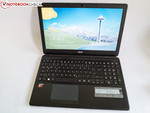
Acer has delivered a solid although somewhat dull office laptop completely clad in black with its Aspire E1-522-45004G50Mnkk. It is especially energy efficient and thus achieves a decent battery runtime. The side effects of the economic APU are seen in a very quiet fan and low temperature development. The large, responsive touchpad alongside the well-implemented keyboard underline the device's suitability for the typical field of use in the office.
The interface array completely covers the standards and the user does not have to fiddle with adapters. The application performance is sufficient for the application field and usually enables smooth work with office-typical software. More demanding programs like Adobe Photoshop Lightroom 4 however push the system to its limits and lead to frequent work breaks. Graphically demanding games are out of the question.
Accessories and software of Acer's E1-522 are limited to the most needed things, but then again the whole system is not stuffed with bloatware. The casing is sufficiently rigid although it features unnecessarily sensitive surfaces. The installed DVD burner can only be considered a gimmick because the laptop lacks power and above all an acceptable screen for a multimedia device.
This finally brings us to the biggest drawback of Acer's E1-522. The screen is much too dark and only provides a moderate although category-typical pixel density. That is worsened by the ever-present reflections of the glossy surface, which is barely acceptable in outdoor use. Hardly anyone expects an accurate color reproduction or perfect illumination in this price range. However, a sufficiently bright and, in particular, low-reflection screen is a decisive ergonomic factor in an office device.


 Deutsch
Deutsch English
English Español
Español Français
Français Italiano
Italiano Nederlands
Nederlands Polski
Polski Português
Português Русский
Русский Türkçe
Türkçe Svenska
Svenska Chinese
Chinese Magyar
Magyar